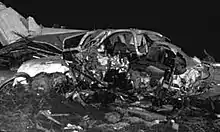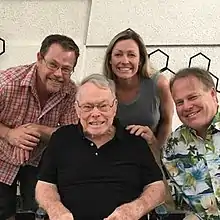James K. Styner
James Kenneth Styner, MD, FACS, is a retired orthopedic surgeon who practiced in Lawndale, California. He was instrumental in the development of the Advanced trauma life support (ATLS) program after his experiences in an unfortunate private airplane crash in rural Nebraska.
Tragedy


On February 17, 1976, after attending a wedding, Styner flew his private airplane (a 6-seat Beach Barron twin) from Los Angeles to his home in Lincoln, Nebraska.[1] His wife, Charlene Styner, and their four children, Christopher, Richard, Randal, and Kimberly Styner, were also aboard. They landed in New Mexico to refuel, crossing Texas, Oklahoma, and Kansas on their way home. In Nebraska, they intercepted a low, thin cloud layer. Styner stayed below the clouds but became disoriented and lost altitude. As a result, the plane crashed into a row of trees at 168 miles per hour.
Charlene was torn from the airplane and killed instantly. Kimberly, Richard, and Randal were unconscious with head injuries. James incurred rib fractures, wounds to his head and face, and a zygomatic fracture. Christopher had a fracture to the right forearm and a severe laceration to the right hand. The two of them were able to evacuate the unconscious children from the aircraft and after eight hours in sub-freezing conditions, James found a nearby road and flagged down a car. They were taken to a hospital a few miles south of the crash site.
The hospital was not open at that hour and it took some time to gather personnel. Once it was open, Dr. Styner found that the hospital staff had little training in the management of serious trauma. He was particularly concerned about the lack of protection for the injured children's cervical spines. He called his partner Bruce Miller, who arranged for their evacuation by helicopter to Lincoln General Hospital.
Advanced Trauma Life Support course
Styner's concern with the lack of a uniform system for treating trauma stuck with him. He said later "When I can provide better care in the field with limited resources than my children and I received at the primary facility, there is something wrong with the system and the system has to be changed." In 1978, he collaborated with several colleagues and the Lincoln Medical Education Foundation to offer the prototype Advanced trauma life support course in Auburn, Nebraska.[2]
In 1980, the American College of Surgeons Committee on Trauma adopted ATLS for domestic and international audiences. Styner himself recertified as an ATLS instructor in 2007, teaching his instructor candidate course in Nottingham, England,[3] and the Netherlands. On March 22, 2013, the American College of Surgeons Committee on Trauma renamed their annual Award for Meritorious Service in ATLS to the James K. Styner Award for Meritorious Service.[4]
References
- The Birth of Advanced Trauma Life Support by James K. Styner, MD, Journal of Trauma Nursing, Vol. 13 No.2, April - June 2006
- Styner, Randy (2012). The Light of the Moon - Life, Death and the Birth of Advanced Trauma Life Support. Kindle Books: Kindle Books. p. 267.
- Nottingham Evening Post July 5 2007
- Croce, Martin; Livingston, David; Luchette, Frederick; Mackersie, Robert (Sep 13, 2013). American Association for the Surgery of Trauma 75th Anniversary 1938-2013. The American Association for the Surgery of Trauma. p. 164. ISBN 978-0989892803. Retrieved 2 September 2020.